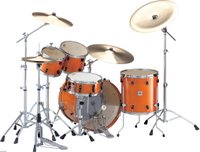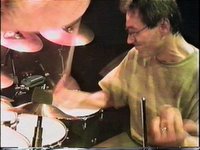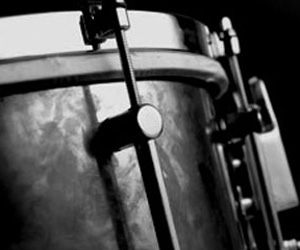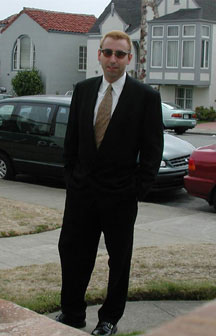Drum Tips - More Efficient Practice Sessions

- Practice does NOT makes perfect.
- PERFECT practice makes perfect.
- CRAPPY practice makes perfectly crappy!
Poorly organized, occasional practice can almost guarantee poor performance. It is exceedingly important to put in the time, but you need to put in the time in the right way. Although, it is difficult to describe a single “correct” way to practice, endlessly practicing incorrectly can lead to big disappointment when you don’t get the great gigs, and can also lead to physical, repetitive stress injuries. Following are a few successful practice tips to help you keep moving forward, and should help make your practice time more valuable.
FIND A GREAT DRUM TEACHER
Work with a great Teacher. I can’t say this enough. A great teacher can help you fix little problems before they become BIG problems. It is always much easier to learn good technique early in life. It can be very difficult and frustrating to go back and unlearn bad technique.FIND A PLACE TO PRACTICE
Where it is located is not really important. I have practiced in bedrooms, garages, professional rehearsal studios, self-storage facilities, old barns, community centers, school classrooms, church, and in open fields, along a quiet stretch of road, near the top of Mount Tamalpais, in Marin, California. A place where you can leave equipment set up is great, so long as it can be securely locked, but anyplace that you can make a lot of noise for an extended period of time will work.If there are folks within earshot, check with them about what hours they can tolerate. Network with your neighbors. Bake a nice plate of cookies and go introduce yourself. Explain that you will be practicing drums nearby, and promise to practice during reasonable hours. Give them your phone number and ask them to call if the practicing ever becomes too loud. I have not received a call yet, but then I try to keep my practice times after 10:00 A.M. and before 8:30 P.M. if I am practicing anyplace other than a professional rehearsal studio or other place with really good sound insulation.
Again if you have neighbors who can hear your practicing, make a diligent effort to dampen the sound as much as you can. Close doors and windows, put up sound-proofing, extra carpeting, etc. Be considerate of your neighbors and not only will they not hassle you about your practice but they may end up being some of your best supporters.
PLAN PRACTICE SESSIONS IN ADVANCE
Know what you want to accomplish before each practice session. Good planning is very important to effective practice. Have several pages of material you want to read through ready to go, know what tempos you are going to work on. An enormous amount time can be wasted in a poorly planned practice session. Sitting at the drumset and playing for hours on end without any structured path can be fun but it will not lead to being a great drummer.Once again, a great teacher can help you organize your practice sessions to get the most out of them! Keep a note book of your practice sessions and keep track of where you are coming from, where you are going to, and the steps you are taking to get there. Remember, the elevator to success is always out of order, you have to take the stairs, one step at a time!
LONG-RANGE/SHORT-RANGE GOALS
Plan long-range as well as short-range goals. Long-range goals are self-set goals for six months or a year from now, such as "I want to be able to play a good samba groove" Short-range goals are for today, like "I am going to learn samba exercises 1 to 10 on page 30." Map out beforehand realistic/obtainable long-range and short-range practice goals, and set out to achieve them.SET UP A SPECIFIC PRACTICE ROUTINE
Follow a specific practice routine each day. The key is to make the best use of available time in order to produce the maximum results. Having a specific practice routine helps you make sure you hit every element of a good practice, and no element of your playing gets missed.A SUGGESTED ROUTINE:
WARM UP (30-60 minutes)
Hands
Singles (3-10 minutes)
Doubles(3-10 minutes)
Triples (3-10 minutes)
Rudiment Variations (5-10 minutes)
Feet
Singles (3-10 minutes)
Doubles (3-10 minutes)
Rudiment Variations (5-10 minutes)
Hands and feet together
Singles (3-10 minutes)
Doubles (3-10 minutes)
Rudiment Variations (3-10 minutes)
Careful thought and evaluation should be given to technique each day during the warm up period.
READING - Part I (60-120 minutes)
Focus on the hands (15-30 minutes)
Focus on the feet (15-30 minutes)
Combined Hands and Feet – Short / 1 to 2 measure patterns (15-30 minutes)
Combined Hands and Feet – Long / 8 to 16 measure patterns (15-30 minutes)Here is where you are learning new concepts and correcting problem spots in old ones. Have a few charts that you are always in the process of working on. Keep track of your tempo for each page. Have specific goals in mind that are determined before beginning to practice. Read through a single pattern 20-30 times at your starting tempo, then move on to the next pattern on the page. If you make it to the bottom of the page kick up the tempo a bit and start at the top again. Remember the goal is to play clean, relaxed, comfortably perfect. Don’t move on to the next pattern or next tempo until you’ve really got it right.
Don't attempt too much in one practice. Take big problems and break them down into a bunch of small problems. then convert them into your short-range goals, and attack them one at a time. It is much better to take a difficult measure and practice it again and again, until played perfectly, than to stop every time that measure is encountered and say, "I always have trouble with this part."
BREAK (5 minutes)Literally, Take a Break During long practice sessions it is important both mentally and physically to take a short break. Let you mind and body relax a bit. Give yourself a cognitive disconnect from the practice session, physically breaking your practice into distributed sessions will help transfer your learning from short term memory into long term memory more efficiently.
READING - Part II (30 minutes)
Sight-ReadingIt is always a good idea to stay on top of your sight-reading skills. Sight-reading skills are among the most underdeveloped musical ability. Daily sight-reading practice will help you in building great technical skills. It is MUCH better when you CAN sight-read, and it is NOT required - than if you CAN’T sight-read, and it IS required.
Keep a small pile of drum books available for you to practice sight-reading. Don't choose material that is too difficult; it become discouraging and also will not carry over to actual situations. On the other hand, don't read music that is too easy, or the skill will not carry over to situations where actual sight-reading is required.
PLAY (30-60 minutes)Take some structured time during your practice session to just play! Sometimes with, and sometimes without a metronome, just let go and do some beats, fills, and free-form soloing. Try to move melodically through some of the things you have been practicing. You want to reinforce the concepts you’ve been learning, but you also want to remember why you wanted to be a drummer in the first place, it’s fun!
REVIEW (30-60 minutes)Go back through what you’ve been working on. Read through the short patterns and long patterns, one after the next, all the way through the page, moving as smoothly as possible through them all. This is a place where I like to get into the strange things like reading a variety of time signatures and trying to make odd-time fills fit smoothly into a 4/4 groove. That sort of thing.
DAILY SCHEDULE
 A dozen great teachers could easily recommend two or three dozen good practice schedules. There is no one “right” answer. There are many good practice methods. This is simply one approach, which has proven successful for me and my students. Take some time, and put together a routine that will work best for you, and put it into practice.
A dozen great teachers could easily recommend two or three dozen good practice schedules. There is no one “right” answer. There are many good practice methods. This is simply one approach, which has proven successful for me and my students. Take some time, and put together a routine that will work best for you, and put it into practice.

